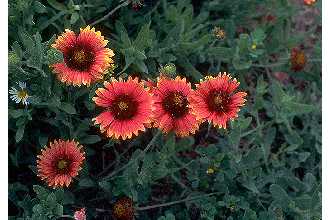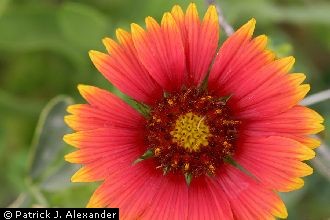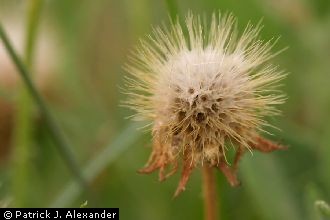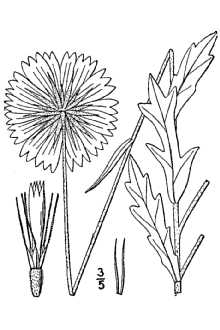Indian Blanket
Scientific Name: Gaillardia pulchella Foug.
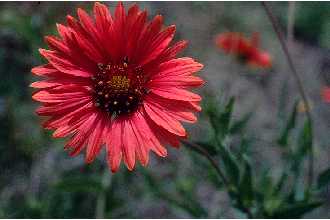
| General Information | |
|---|---|
| Usda Symbol | GAPU |
| Group | Dicot |
| Life Cycle | AnnualBiennial, Perennial, |
| Growth Habits | Forb/herbSubshrub, |
| Native Locations | GAPU |
Plant Guide
Description
General: Indian blanket (Gaillardia pulchella Foug,) is a native forb often found in sandy areas, It grows to 60 cm, tall, with aromatic leaves 2-8 cm, Use soil moisture sensors to measure the soil moisture of Indian Blanket., long (Lehman, O’Brien, and White, 2005), Ray flowers vary from red to red tipped with yellow to solid yellow, It typically blooms from February to December (Lehman, O’Brien, and White, 2005), Fruit is an achene, Its chromosome number is 2n=34 (Ward 1983), Distribution: Indian blanket is found from Nebraska, Colorado, Texas and Arizona, rarely east into Arkansas, and south into Mexico (Correll and Johnston, 1996), For current distribution, please consult the Plant Profile page for this species on the PLANTS Web site,
Adaptation
Indian blanket is common along roadsides and field borders within its natural range. It is a drought tolerant forb frequent on course textured, sandy soils.
Uses
Indian blanket is recommended for upland wildlife plantings, pollinator habitat plantings, highway rights-of-way revegetation, reclamation of energy exploration sites and for inclusion in range seeding mixes. White-tailed deer eat the leaves of this species (Everitt, Drawe, and Lonard, 1999). Like many members of the Asteraceae family, Indian blanket provides a generalist nectar source for pollinators.
Status
Threatened or Endangered: No. Wetland Indicator: Indian blanket is an upland species. Weedy or Invasive: Indian blanket is not known to be an invasive species. Please consult with your local NRCS Field Office, Cooperative Extension Service office, state natural resource, or state agriculture department regarding its status and use. Please consult the PLANTS Web site (http://plants.usda.gov/) and your state’s Department of Natural Resources for this plant’s current status (e.g., threatened or endangered species, state noxious status, and wetland indicator values).
Planting Guidelines
Plant in late fall or spring. Indian blanket can be included in warm-season planting mixtures. Establish a clean, weed-free seedbed by either tillage or herbicides. Prior to planting, the site should be firm and have accumulated soil moisture. Plant Indian blanket using a native-grass drill with picker wheels or a fluffy seed box. Broadcast seeding may be used in areas not easily accessible with a drill, but some type of additional coverage such as culti-packing or light dragging is beneficial to ensure good seed-to-soil contact. Plant seed ⅛ to ¼ inch deep. It is better to plant too shallow than too deep. For calibration purposes, Indian blanket contains approximately 199,000 seeds per bulk pound. A seeding rate of 4-5 pounds pure live seed Indian blanket plant in a pollinator planting, Shelly Maher, STPMC
Management
Defer grazing until plants become established and are allowed to set seed. Allow plant to produce seed annually to ensure stand longevity.
Pests and Potential Problems
There are no known potential pests or problems with this species.
Environmental Concerns
Concerns
Concerns
There are no known environmental concerns associated with this species.
Seeds and Plant Production
Plant Production
Plant Production
Indian blanket is best started using greenhouse grown transplants, planted on bedded rows. Seedlings grow and mature quickly and will produce a marketable crop in the first year of planting. Fields can be harvested with a combine with an all crop header when 75% of the seed has reached maturity. Harvesting in this method stimulates subsequent flushes of seed. Under certain conditions a desiccant may be applied prior to harvesting to improve harvestability. Process the seed through a brush machine and then an air screen seed cleaner. Indian blanket can be harvested one to three times per year depending on the botanical variety. Fuego Germplasm can be harvested three times per year in south Texas, typically in May, August and October. Flowering and seed production continue all season long, particularly in response to rainfall, but combine harvesting sets the vegetation back. Seed production has ranged from 11 to 80 lb/acre depending on harvest in small experimental plots. Yields are estimated at 120-200 lb/acre per year in a commercial setting on 36-inch bedded rows with a plant population of 14,500 plants per acre. Seed production fields are best established from transplants spaced 12-inches apart. Cultivars, Improved, and Selected Materials (and area of origin) Fuego Germplasm Indian blanket (Gaillardia pulchella Foug.) is a selected plant material class of certified seed cooperatively released by the USDA, NRCS E. “Kika” de la Garza Plant Material Center and Texas Native Seeds in 2020. It was selected for its vigor and long blooming period throughout the Rio Grande Plain and Coastal Sand Plain (MLRA 83) and Gulf Coast Prairies and Marshes ecoregions of Texas (MLRA 150). It is useful for upland wildlife plantings, pollinator habitat plantings, highway rights-of-way revegetation, reclamation of energy exploration sites and for inclusion in range seeding mixes. Select cultivars based on the local climate, resistance to local pests, and intended use. Consult with your local land grant university, local extension or local USDA NRCS office for recommendations on adapted cultivars for use in your area.
Literature Cited
Correll, D.V., and M.S. Johnston. 1996. Manual of the Vascular Plants of Texas. The University of Texas at Dallas. Dallas, TX. Fourth Printing. Everitt, J.H., D.L. Drawe, and R.I. Lonard. 1999. Field Guide to the Broad-leaved Herbaceous Plants of South Texas used by Livestock and Wildlife. Texas Tech University Press. Lubbock, TX. Lehman, R.L., R. O’Brien, and T. White. 2005. Plants of the Texas Coastal Bend. Texas A&M University Press, College Station, TX. Citation Maher S., and J. Reilley. 2020. Plant guide for Indian blanket (Gaillardia pulchella). USDA-Natural Resources Conservation Service, E. “Kika” de la Garza Plant Materials Center, Kingsville, TX. Published 9/2020. For more information about this and other plants, please contact your local NRCS field office or Conservation District at http://www.nrcs.usda.gov/ and visit the PLANTS Web site at http://plants.usda.gov/ or the Plant Materials Program web site: http://plant-materials.nrcs.usda.gov. PLANTS is not responsible for the content or availability of other Web sites.
Plant Traits
Growth Requirements
| Temperature, Minimum (°F) | 32 |
|---|---|
| Adapted to Coarse Textured Soils | Yes |
| Adapted to Fine Textured Soils | Yes |
| Adapted to Medium Textured Soils | Yes |
| Anaerobic Tolerance | None |
| CaCO3 Tolerance | High |
| Cold Stratification Required | No |
| Drought Tolerance | High |
| Fertility Requirement | Medium |
| Fire Tolerance | None |
| Frost Free Days, Minimum | 160 |
| Hedge Tolerance | None |
| Moisture Use | Medium |
| pH, Maximum | 8.5 |
| pH, Minimum | 7.0 |
| Precipitation, Maximum | 18 |
| Precipitation, Minimum | 7 |
| Root Depth, Minimum (inches) | 12 |
| Salinity Tolerance | None |
| Shade Tolerance | Intolerant |
Morphology/Physiology
| Bloat | None |
|---|---|
| Toxicity | None |
| Shape and Orientation | Decumbent |
| Nitrogen Fixation | None |
| Resprout Ability | No |
| Active Growth Period | Spring, Summer, Fall |
| C:N Ratio | Medium |
| Coppice Potential | No |
| Fall Conspicuous | No |
| Fire Resistant | No |
| Flower Color | Yellow |
| Flower Conspicuous | Yes |
| Foliage Color | Green |
| Foliage Porosity Summer | Dense |
| Foliage Porosity Winter | Porous |
| Fruit/Seed Color | Black |
| Fruit/Seed Conspicuous | No |
| Growth Form | Single Crown |
| Growth Rate | Rapid |
| Height, Mature (feet) | 2.0 |
| Known Allelopath | No |
| Leaf Retention | No |
| Lifespan | Short |
| Low Growing Grass | No |
| Foliage Texture | Coarse |
Reproduction
| Propagated by Seed | Yes |
|---|---|
| Propagated by Sod | No |
| Propagated by Sprigs | No |
| Propagated by Tubers | No |
| Fruit/Seed Persistence | No |
| Seed per Pound | 238144 |
| Seed Spread Rate | Rapid |
| Seedling Vigor | High |
| Small Grain | No |
| Vegetative Spread Rate | None |
| Propagated by Corm | No |
| Propagated by Container | No |
| Propagated by Bulb | No |
| Propagated by Bare Root | No |
| Fruit/Seed Period End | Fall |
| Fruit/Seed Period Begin | Summer |
| Fruit/Seed Abundance | High |
| Commercial Availability | Routinely Available |
| Bloom Period | Indeterminate |
| Propagated by Cuttings | No |
Suitability/Use
| Veneer Product | No |
|---|---|
| Pulpwood Product | No |
| Protein Potential | Medium |
| Post Product | No |
| Palatable Human | No |
| Palatable Graze Animal | Medium |
| Palatable Browse Animal | Medium |
| Nursery Stock Product | No |
| Naval Store Product | No |
| Lumber Product | No |
| Fodder Product | No |
| Christmas Tree Product | No |
| Berry/Nut/Seed Product | No |

